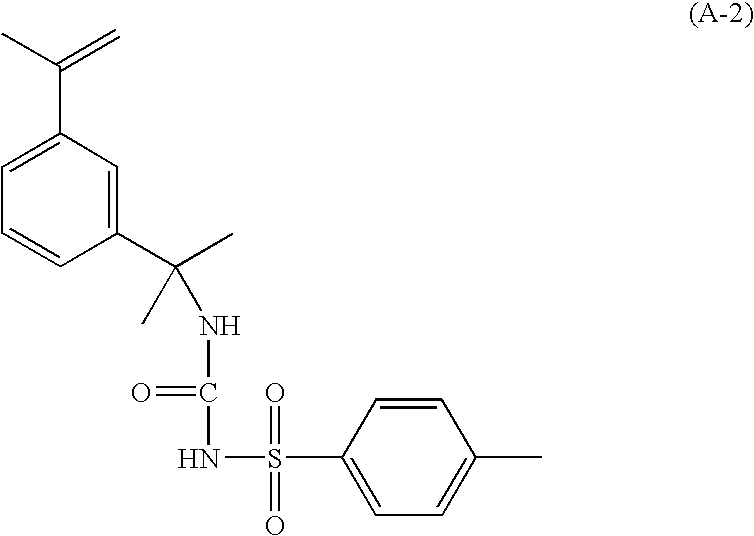Multilayer imageable element containing sulfonamido resin
a technology of sulfonamido resin and imageable elements, which is applied in the field of multi-layer imageable elements containing sulfonamido resin, can solve the problems of time-consuming process, affecting the quality of imageable elements, and the appearance of masks may change slightly, so as to reduce the formation of sludg
- Summary
- Abstract
- Description
- Claims
- Application Information
AI Technical Summary
Benefits of technology
Problems solved by technology
Method used
Image
Examples
examples
[0108]The components and materials used in the examples and analytical methods were as follows:
[0109]MEK is methyl ethyl ketone.
[0110]DEK is diethyl ketone.
[0111]PGME is 1-methoxypropan-2-ol. It is also known as Dowanol PM.
[0112]BLO is γ-butyrolactone.
[0113]PMA is 1-methoxy-2-propyl acetate.
[0114]IR dye A is Kayasorb PS210CnE, an infrared absorbing dye as supplied by Nippon Kayaku Co, Ltd. (Tokyo, Japan).
[0115]IR absorbing Dye B was obtained from Eastman Kodak Company and is represented by the following formula:
[0116]
[0117]JK69 is a copolymer having recurring units derived from N-phenylmaleimide (40 mol %), methacrylamide (35 mol %), and methacrylic acid (25 mol %).
[0118]JK58 is a copolymer having recurring units derived from N-phenylmaleimide (50 mol %), methacrylamide (35 mol %), and methacrylic acid (15 mol %).
[0119]Ethyl violet is C.I. 42600 (CAS 2390-59-2, λmax=596 nm) having a formula of (p-(CH3CH2)2NC6H4)3C+Cl− (Aldrich Chemical Company, Milwaukee, Wis., USA).
[0120]TSD01 is a...
examples 1 – 3
Examples 1–3
[0139]Imageable elements of this invention were prepared using the following inner and outer layer formulations:
[0140]Inner layer formulations were prepared with the components described in TABLE I below and applied to Substrate A using a 0.012 inch (0.03 cm) wire-wound bar and dried for 30 seconds at 135° C. to provide a dry coated film of approximately 1.5 g / cm2.
[0141]Topcoat (outer layer) solutions were prepared with the components described in TABLE II below and applied with a 0.006 inch (0.015 cm) wire-wound bar and dried at 30 seconds at 135° C. to provide a dry coat weight of approximately 0.6 g / cm2 for Examples 1 and 2, and about 0.5 g / cm2 for Example 3.
[0142]
TABLE IJK69IR Dye AIR Dye BByk ®-307Solvent*Inner Layer5.690.70.560.4692.59*MEK / methyl lactate / BLO / water at a weight ratio of 50:30:10:10
[0143]
TABLE IIPolymer C (40%Polymer D (40%ExamplePolymer APolymer Bsolids in DEK)solids in DEK)Ethyl violetByk ®-307Solvent*10.5850.9000.30.1223.095200.62.21200.30.1221.768...
examples 4 – 6
Examples 4–6
[0151]Imageable elements of this invention were prepared using the following inner and outer layer formulations:
[0152]Inner layer formulations were prepared with the components described in TABLE IV below and applied to Substrate A using a 0.012 inch (0.03 cm) wire-wound bar and dried for 30 seconds at 135° C. to provide a dry coated film of approximately 1.5 g / cm2.
[0153]Topcoat (outer layer) solutions were prepared with the components described in TABLE V below and applied with a 0.006 inch (0.015 cm) wire-wound bar and dried at 30 seconds at 135° C. to provide a dry coat weight of approximately 0.6 g / cm2.
[0154]
TABLE IVJK58IR Dye AIR Dye BByk ®-307Solvent*Inner Layer5.690.70.560.4692.59*MEK / methyl lactate / BLO / water at a weight ratio of 50:30:10:10
[0155]
TABLE VPolymer CPoly-(40% solidsPoly-EthylByk ®-Examplemer Ain DEK)mer Eviolet307Solvent*403.71200.30.1220.86851.485000.30.1223.0956001.4850.30.1223.095*DEK / PMA at a weight ratio of 92:8
[0156]The imageable elements were t...
PUM
| Property | Measurement | Unit |
|---|---|---|
| weight % | aaaaa | aaaaa |
| thickness | aaaaa | aaaaa |
| mol % | aaaaa | aaaaa |
Abstract
Description
Claims
Application Information
 Login to View More
Login to View More - R&D
- Intellectual Property
- Life Sciences
- Materials
- Tech Scout
- Unparalleled Data Quality
- Higher Quality Content
- 60% Fewer Hallucinations
Browse by: Latest US Patents, China's latest patents, Technical Efficacy Thesaurus, Application Domain, Technology Topic, Popular Technical Reports.
© 2025 PatSnap. All rights reserved.Legal|Privacy policy|Modern Slavery Act Transparency Statement|Sitemap|About US| Contact US: help@patsnap.com



